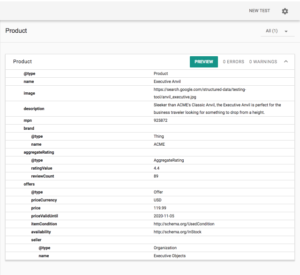Even if you’re only selling something, you need to keep Google updated. Do not assume that your websites are crawled by people, either.
As a result, Google’s algorithms sift through your website to list you and thus rank you. These “bots” are illiterate in English. Instead, they focus on the coding you use to organize your data.
What is Schema Markup?
To improve search engine results for users, add schema markup code to your website. Your listing will be more visible and more likely to get clicks if you add metadata that search engines may use.
In the end, schema markup is nothing more than a form of microdata. HTML’s microdata specification is used to nest metadata within the current online text. Microdata can be extracted and processed by search engines, web crawlers, and browsers and used to enrich the surfing experience for users.
Organisation Schema markup, for example, will result in a more detailed search result description (also known as a “rich snippet”)
Using microdata can make it easier for search engines to crawl your website’s structure, making it more likely to appear higher in search results.
Schema markup can incorporate ratings, reviews, and events, among other things. ‘ Using schema markup, you may add vital information to your Google and Yahoo search results. Featured snippets in search results will be simpler to find due to this. For example, you can include a star rating in your product’s description.
Riches that Come through Hard Work
A website’s ability to produce Rich Results in Google’s search results relies on structured data, often known as schema markup.
These Rich Results give you a clear picture of what’s most important on your site. Instead of accessing the link, a user can receive critical information about your page from search results.
Depending on the content on your page, you can expect a variety of rich outcomes.
It’s only through structured data that search results like reviews, ratings, and ingredients (if you’re looking for a recipe) show up.
Schema Markups: A Step-by-Step Guide

Step 1: Making a script that Google will adore
Scripts are commonly used to create schemas. If this is done in the JavaScript Object Notation for linked data (JSON-LD) or in JSON-LD, Google prefers it. So if you’re planning on developing this type of code, know that a single mistake can cause your page to go down.
Schemas are no longer a hassle, thanks to generators’ simplicity. Knowing that even programmers despise coding, it’s only logical that we would also opt for a more straightforward solution.
This article will go through the two most significant ways to generate schemas without writing code.
· Merkle’s Technical SEO Schema Markup Generator
· Structured Data Markup Helper from Google
Let’s start with Merkle’s suggestion.
Select the type of page you want to create schema markup for by visiting https://technicalseo.com/tools/schema-markup-generator.
For example, let’s establish schemas for our current post about hotel SEO by creating schemas.
The activity may be completed in less than five minutes despite the page’s length. Believe us when we say the outcomes are worth the effort, especially if you receive lucrative ones. Furthermore, since you only need two tabs to get started, there isn’t much back and forth.
We’ll open up our blog and our schema generators on separate tabs as a starting point.
The blog’s URL is the most important thing to you. Using the URL as a starting point, you can proceed to the schema generator.
There are two options here: “Articles” and “blog posting.”
The URL can then be pasted into the form, and we can continue filling it out as needed.
Step 2: Test the Generated Schemas
Aren’t there three little arrows in the upper-right corner? Go ahead and press “G” to begin testing your code. There should be two choices.
The ‘Structured Data Testing Tool’ and ‘Google’s Rich Results Test’ are two separate links.
The Structured Data Testing Tool will send you to www.schema.org, where you should see a positive result after pressing the test button and any problems or warnings that may have occurred while testing can be solved by professional seo service.
If ‘No mistakes and no warnings’ can be seen. You can now look for ‘Rich Results,’ too.
Step 3: Schema implementation. Bring it to Life!
No mistakes should be seen if you have followed the procedure correctly.
Then, all you have to do is go to the source code of your page.
A content management system such as WordPress should make it easy to find. Please have a peek at our new blog page.
It’s that simple. A single page of Schema Markup has been completed! After that, you have to repeat the process for each page where structured data is desired.
Step 4: Congratulations, and repeat
As each page’s schema markup is customised uniquely, the process must be repeated for every page. Depending on the number of pages on your website, this may take a while to complete. But don’t worry, it’s only going to be a one-time thing.
And after you’re done, Google will be able to read and understand your website so that you can connect with your target audience.
The creation and implementation of schema markups have become much more straightforward. For more information on how Google crawls, indexes, and ranks your website and how to improve it, check out our blog.
As long as you adhere to the recommendations, you should be alright
Check out Google’s Structured Data Guidelines to ensure you don’t cross the line. This is a lengthy number of rules, but just three variables better summarise it.
All you need to do is watch out for the following things:
· Ensuring that all of the content is accessible and understandable.
· Evaluation of markups to ensure they are correct is part of this step (later on).
· Everything is arranged in the correct order (after all, this is what constitutes structured data).
It’s a shame the list is so long, but you can find them here if you’d instead read the details.
This guide should have provided you with everything you need to generate flawless schema markups for your website, and we sincerely hope it did. Don’t hesitate to tell us if you have any questions in the comments box below!
Conclusion
Schema markup may appear complicated you can refer technical SEO guide to know the steps, but the process is relatively straightforward. It is possible to improve your search engine rankings and increase click-through rates by using schema markup code.






